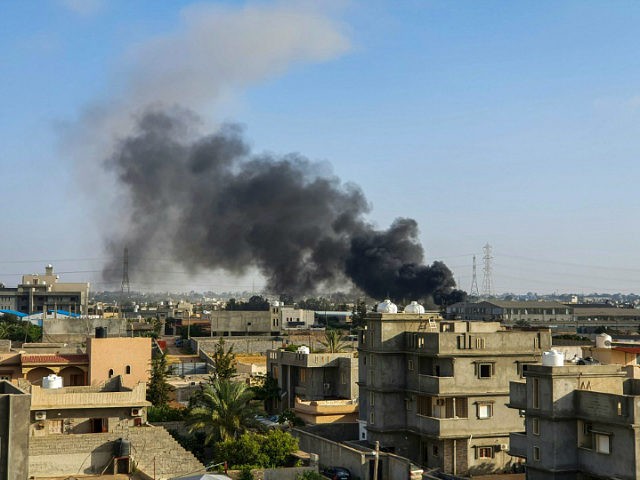Forces loyal to renegade Gen. Khalifa Haftar on Monday launched airstrikes on the coastal city of Sirte currently held by the internationally recognized government, expanding the conflict beyond the capital of Tripoli.
Since April, Haftar’s self-styled Libyan National Army (LNA) has been trying to take Tripoli from the Government of National Accord (GNA) headquartered there. The LNA has conquered most of Libya with the help of Russia, France, Egypt, Saudi Arabia, and the United Arab Emirates (UAE) but has failed to take Tripoli.
Some of Haftar’s international supporters are reportedly helping the warlord with airstrikes against the United Nations-brokered GNA and its backers, backed by Turkey and Qatar.
Human rights groups have accused both warring sides — the LNA and GNA — of war crimes against civilians in Libya.
Referring to the Tripoli operation, Reuters reports:
The campaign has displaced more than 120,000 people in Tripoli alone, killed hundreds of civilians, and risks disrupting oil supplies from the country in chaos since the toppling of Muammar Gaddafi in 2011.
There have been LNA-claimed strikes in recent days on Sirte, some 450km (280 miles) by road east of Tripoli, but mainly on the outskirts, residents said.
Haftar … might be trying to shift the frontline [to] Sirte away from Tripoli where he has been unable to breach the city’s defenses and even lost his main forward base in Gharyan, said Emad Badi, a Libya researcher.
Such a move would also pre-empt attacks on the main LNA supply base in Jufra, a central oasis, which the Tripoli forces have attacked by air, said Badi, a non-resident scholar at the Middle East Institute.
Jufra borders Sirte in the north and the oasis town of Murzuq in the south. In August, the U.N. expressed concern about the growing number of casualties stemming from airstrikes, rocket attacks, shelling, and direct ground engagements in Murzuq. The U.N. warned that the region is facing a “humanitarian crisis” linked to the ongoing fighting.
LNA troops reportedly targeted GNA-allied local forces charged with securing Sirte.
Moreover, the U.N-backed government reportedly said on Facebook that drones operated by Haftar ally, the UAE, had attacked some of its partners in the region.
Haftar and his LNA are loyal to the breakaway government based in eastern Libya’s Tobruk region. Haftar’s supporters believe he can bring stability and defeat the jihadi groups operating in Libya. Since the U.S.-backed fall and subsequent death of dictator Gaddafi, Libya descended into chaos with rivaling governments competing for power and jihadi group’s establishing a foothold.
“Haftar’s critics accuse him of trying to seize power through a military coup, deepening a conflict between factions based in the east and west of the sprawling North African country,” Reuters noted.
American officials and other observers once considered Sirte the largest Islamic State (ISIS/ISIL) stronghold outside of Iraq and Syria.
In December 2016, the U.S. military helped local militias retake Sirte from ISIS, but the terrorists continue to operate in and around the area.
Sirte sits alongside the unofficial border between the western territory controlled by the GNA based in Tripoli and the eastern lands held by the LNA’s renegade government in Tobruk.
Some ISIS fighters are trying to regroup in and around Sirte, some Libyans warned in April, according to the Middle East Eye (MEE).
The jihadi group wants to strengthen their position, while the LNA and GNA annihilate one another.
Haftar has accused the GNA of working with ISIS and other jihadis.
The LNA and GNA have intensified airstrikes in recent weeks in anticipation of a conference in Germany that is expected to bring together the foreign stakeholders active in the North African country.

COMMENTS
Please let us know if you're having issues with commenting.